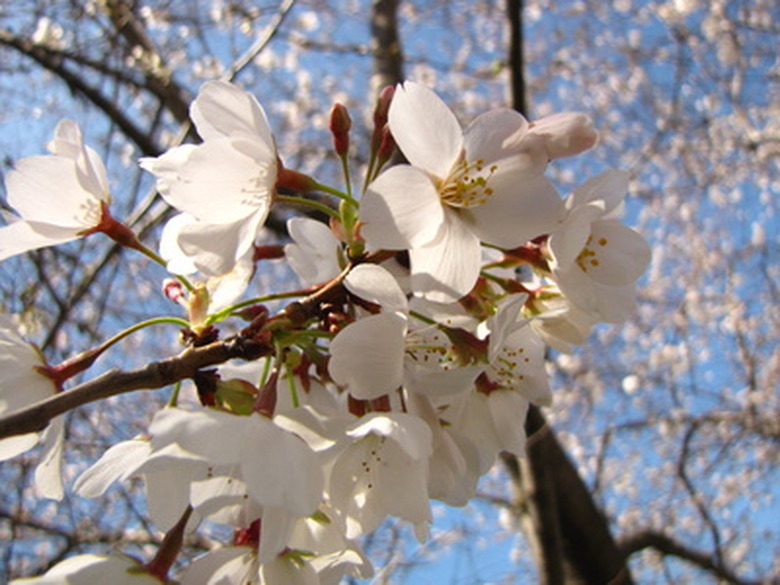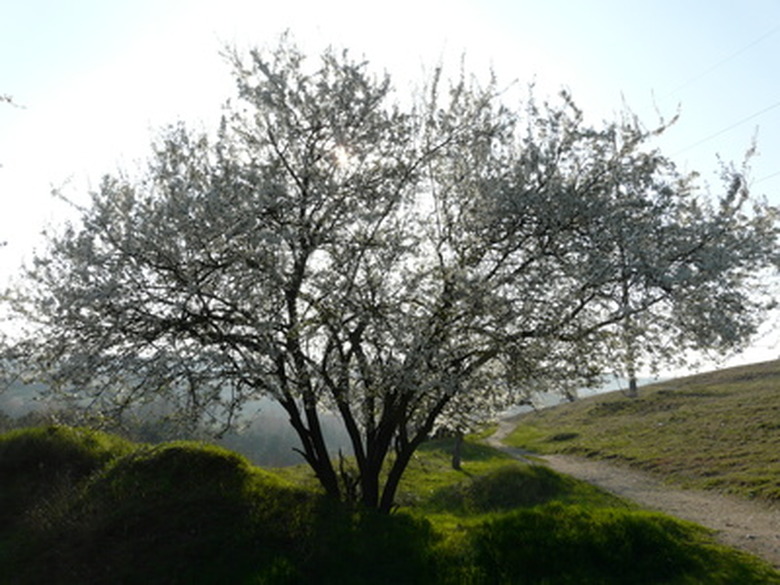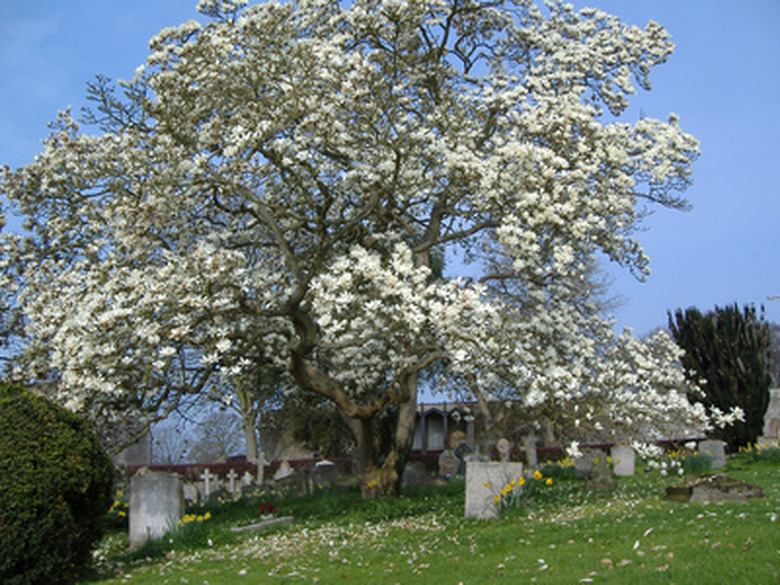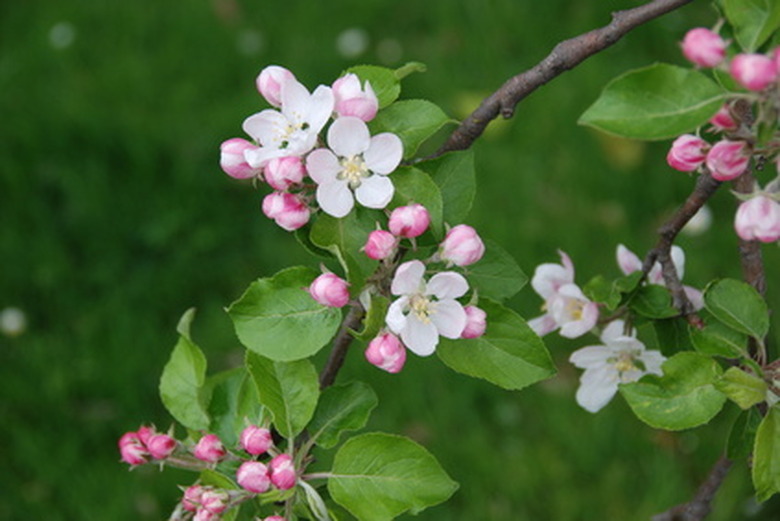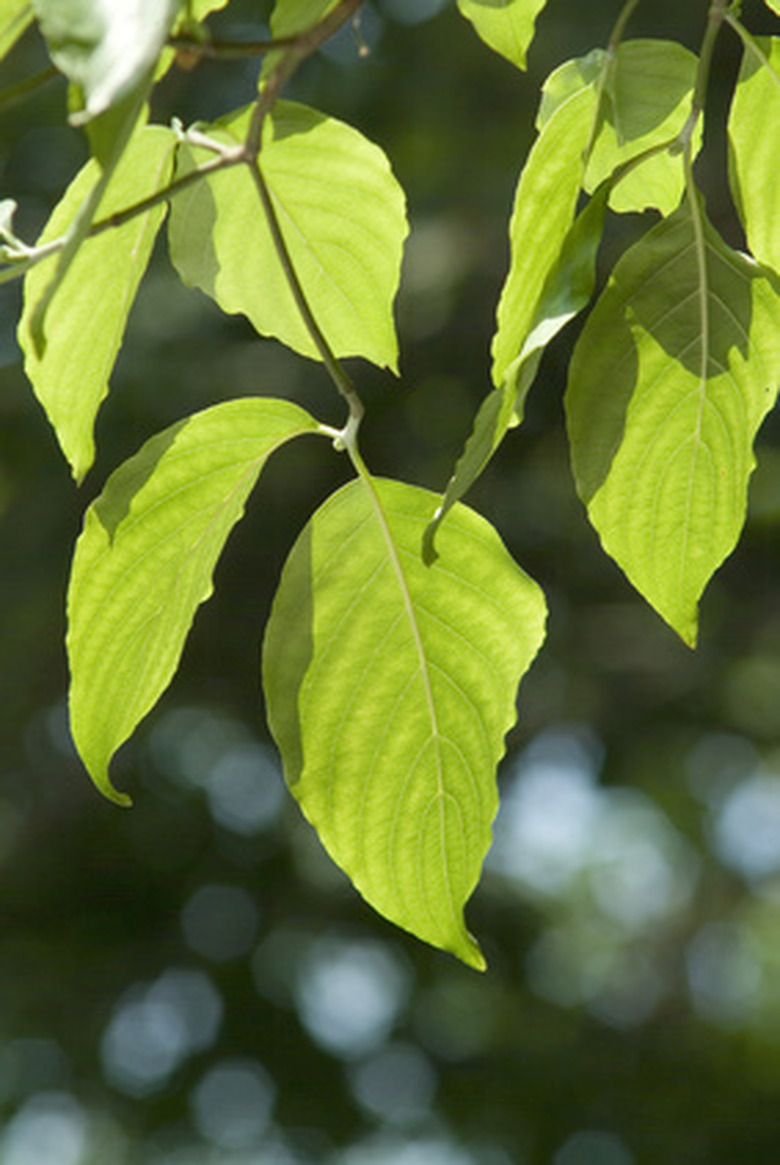How To Identify A White Flowering Tree
Many different tree species bloom in white flowers, some with very large, showy blossoms and others with more inconspicuous blooms. The most common white flowering trees you're likely to see are the autumn cherry, crabapple, white and Kousa dogwoods, pear and Carolina silverbell, as well as the star, Southern and sweetbay magnolias. The best time to identify a white flowering tree is when it's in bloom and has yet to drop its leaves, giving you many different physical attributes to use as clues in your tree identification.
Step 1
Identify the white flowering tree by the climate where it's growing. Natchez Crape Myrtle and European olive trees grow in regions with mild winters, while the mountainash grows in colder climates with winter temperatures down to -40 degrees Fahrenheit. All other white flowering trees grow in climates where winter temperatures stay above -25 degrees.
Step 2
Identify the white flowering tree by its size. The Northern Catalpa grows 40 to 60 feet tall, but the Southern magnolia can grow up to 80 feet in height. European olive, Carolina silverbell, sourwood, pear and cherry trees can reach 35 to 40 feet tall, while the crabapple, mountainash, Kousa dogwood, Mexican plum and sweetbay magnolia grow to only 10 to 15 feet tall. The white dogwood, star magnolia, Washington Hawthorn, purpleleaf plum and star magnolia grow up to 20 to 25 feet tall.
- Many different tree species bloom in white flowers, some with very large, showy blossoms and others with more inconspicuous blooms.
- The most common white flowering trees you're likely to see are the autumn cherry, crabapple, white and Kousa dogwoods, pear and Carolina silverbell, as well as the star, Southern and sweetbay magnolias.
Step 3
Study the white flowering tree's form. The Washington Hawthorn has a pyramid-shaped canopy, while the sourwood's crown is oval or slightly pyramidal. The Catalpa, Southern magnolia, star magnolia, mountainash and pear trees all have oval-shaped canopies, while the sweetbay magnolia has a columnar shape and the Natchez Crape Myrtle has a wide, spreading, slightly umbrella-shaped canopy. European olive, Mexican plum and purpleleaf plum trees have rounded crowns, while cherry, crabapple, Kousa and white dogwood, and Carolina silverbell trees have rounded but wide-spreading, horizontally branching crowns.
Step 4
Look at the flower size and shape . The cherry tree has delicate flowers in semi-double blooms, while the crabapple has five-petaled, three-quarter-inch-wide flowers with golden stamens and the white dogwood has clusters of blooms surrounded by four petal-like bracts. The Southern magnolia has intensely fragrant, 12-inch-wide blooms, the star magnolia has 3- to 4-inch-wide fragrant blooms and the sweetbay magnolia has 2- to 3-inch-wide flowers with a light lemon scent. Pear trees bloom in clusters of 1-inch-wide flowers, while the Carolina silverbell has clusters of bell-shaped flowers.
- Study the white flowering tree's form.
- The cherry tree has delicate flowers in semi-double blooms, while the crabapple has five-petaled, three-quarter-inch-wide flowers with golden stamens and the white dogwood has clusters of blooms surrounded by four petal-like bracts.
Step 5
Identify the white flowering tree by studying its leaves. The Catalpa has distinct, heart-shaped leaves that grow up to 12 inches long, while the Southern magnolia's leaves are 5- to 10-inches long, leathery and shiny green on the tops with reddish undersides. The crabapple has oval, 2- to 4-inch-long leaves that are alternately arranged on the stems and have finely serrated edges. The Kousa and white dogwoods have oval, oppositely arranged 3- to 4-inch-long dark-green leaves, while the sweetbay magnolia has dark-green leaves with silver undersides.
Step 6
Look for the leaves turning colors in autumn. The Washington Hawthorn's leaves are reddish-purple in spring, turning to dark-green in summer and orange, scarlet or purplish in fall. The European olive tree's leaves stay green year round, while the pear tree's leaves are dark-green in summer and turn orange to reddish-purple in fall. The Mexican plum's leaves turn bright-orange in fall, while the sourwood's deep glossy-green leaves turn rusty orange to deep scarlet in autumn.
- Identify the white flowering tree by studying its leaves.
- The Catalpa has distinct, heart-shaped leaves that grow up to 12 inches long, while the Southern magnolia's leaves are 5- to 10-inches long, leathery and shiny green on the tops with reddish undersides.
Step 7
Note when the tree blooms. The crabapple, star magnolia, pear, purpleleaf plum, Carolina silverbell, white dogwood, mountainash and European olive trees bloom in the springtime. The Catalpa, Kousa dogwood, Washington Hawthorn, Southern magnolia and sweetbay magnolia trees bloom May through June, but cherry trees can also re-bloom in the fall. The Mexican plum tree blooms in February and March, while the Natchez Crape Myrtle and sourwood trees bloom throughout the summer months.
